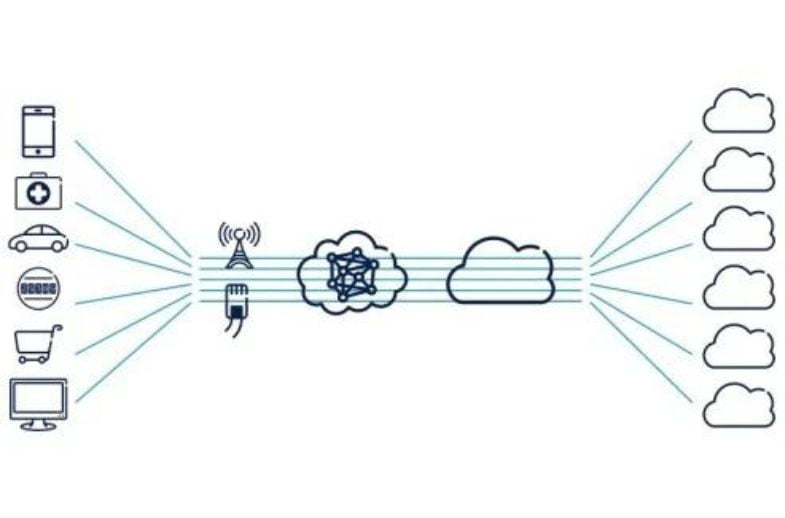Network Slicing for Edge Computing: Everything You Should Know

The combination of edge computing and network slicing has resulted in a new period of innovation, enabling new flexibility and efficiency in providing services and applications. Combining these two enables specialized resources and expertise to be assigned to particular advanced applications or services, improving the user experience and performance. The technology known as “network slicing,” which generates several virtualized network elements within a single physical network infrastructure, is fast-expanding edge computing.
What is Network Slicing?
Using a dynamic structure called “network slicing,” one physical network can be divided into several digital networks suitable for handling different use cases, apps, or services. These slices can be customized to meet the needs of many other applications or customers because they function independently and have dedicated resources. Network slicing uses technologies like Network Function Virtualization (NFV) and Software-Defined Networking (SDN) to generate separate, software-defined network instances.
While sharing the basic network infrastructure, each slice may have its group of services, quality of service (quality of service) parameters, and security controls. Because each piece can be modified to prioritize different customers or applications, this enables effective resource utilization and optimization. Better scalability and flexibility are also made possible by network slicing since it is simple to add or modify new slices without affecting the network’s overall structure or system.
Edge Computing Explained
A change from the standard centrally administered cloud computing model to a more geographically dispersed one is represented by edge computing. Edge computing uses localized processing and storage resources instead of distant data centers. This is especially helpful in applications where continuous processing is important, and latency is a concern. Edge computing plays an increasingly important role with the increasing number of IoT devices and applications, such as automatic cars. Edge computing brings processing power closer to the point of data generation, resulting in faster data processing and less network latency. This is perfect for time-sensitive applications like automatic cars and smart cities.
The Combination of Network Slicing and Edge Computing
Edge computing and network slicing have several important benefits when combined.
Customization
Edge computing environments commonly deal with many different applications with unique requirements. Network slicing makes it possible to modify network resources to meet the unique needs of these applications. High bandwidth and low latency might be prioritized in an industrial Internet of Things application, but ultra-low latency and high reliability can be found in a healthcare application. Edge computing environments can maximize the effectiveness and performance of individual applications by customizing network resources through network slicing. As a result, overall productivity and user experience are enhanced, as are the unique requirements of multiple industries.
Scalability
Network slicing enables the smooth scalability of resources as edge computing environments, and the number of connected devices and applications grow. Operators ensure the network is the proper size for the job by deploying extra network slices. This ensures that the network can handle the increasing demands without harming performance or the user experience. Network slicing makes resource utilization successful since operators can assign specific resources to different slices according to their requirements and priorities.

Resource Efficiency
Utilizing network slicing helps prevent the underuse and overprovision of resources by optimizing their allocation. This results in a more affordable system usage in terms of operations. Network slicing allows for dynamic resource deployment, meaning resources can be easily divided and moved based on new demand. This ensures that facilities are always used effectively, increasing the network’s overall resource efficiency.
Security
Every network portion has its security controls and can be separated. This separation improves security and privacy by preventing unauthorized access or interference between applications and services. Network slicing makes designing unique security processes for every slice possible, ensuring that different and specific security needs are satisfied for multiple user groups or applications. Because flaws or breaches may be identified and fixed without impacting the entire network, network slicing makes monitoring and handling security problems easier.
Quality of Service
Strict service requirements are usually associated with edge computing. High-priority apps can be assigned dedicated resources through network slicing, guaranteeing reliable and steady performance. This ensures that innovative applications, like live-streaming video or automated cars, get the bandwidth and low latency required to function at their best. Network slicing also makes it possible to divide resources dynamically in response to demand, improving the overall service quality and allowing for more effective use of network capabilities.
Read Also: How to Identify a Good Digital Adoption Platform for Microsoft Products
Use Cases for Network Slicing in Edge Computing
Many industries can benefit greatly from the collaboration between edge computing and network slicing.
Healthcare
High reliability and low latency are essential in telemedicine and remote patient monitoring. Network slicing makes sure that medical data can be processed and transferred easily. This enables continuous monitoring and analysis of patient data, facilitating faster diagnosis and treatment decisions. Network slicing enables safe and isolated communication channels, ensuring the confidentiality and privacy of private medical data.

Automated Cars
Extremely low-latency connections are necessary for automated car safety. Network slicing can ensure that there is always the capacity and responsiveness needed. The data transmission can be prioritized and optimized to reduce delays or problems by identifying specific network slices for self-driving cars. This improves road safety by enabling the efficient exchange of immediate information between the vehicle and its surroundings, such as sensor data and updates.
Smart Cities
Network slicing makes it possible to use resources efficiently to support the multiple needs of urban environments, from intelligent traffic management to smart networks. For example, network slicing can divide dedicated slices for traffic monitoring and control systems, allowing data analysis and traffic flow optimization. Network slicing also enables the implementation of intelligent grids and effective energy management systems to ensure sustainable and environmentally friendly urban development.
Conclusion
The collaboration of network slicing and edge computing transforms the digital landscape, offering unprecedented customization, scalability, and efficiency. This dynamic duo is set to revolutionize industries ranging from healthcare to autonomous vehicles, enabling precision delivery of real-time, mission-critical applications.
As the world becomes more interconnected and data-driven, the strategic implementation of network slicing in edge computing environments will be a key driver of innovation and efficiency, heralding a new era of technological possibilities. Businesses and organizations must embrace these technologies to stay competitive and harness their full potential.






